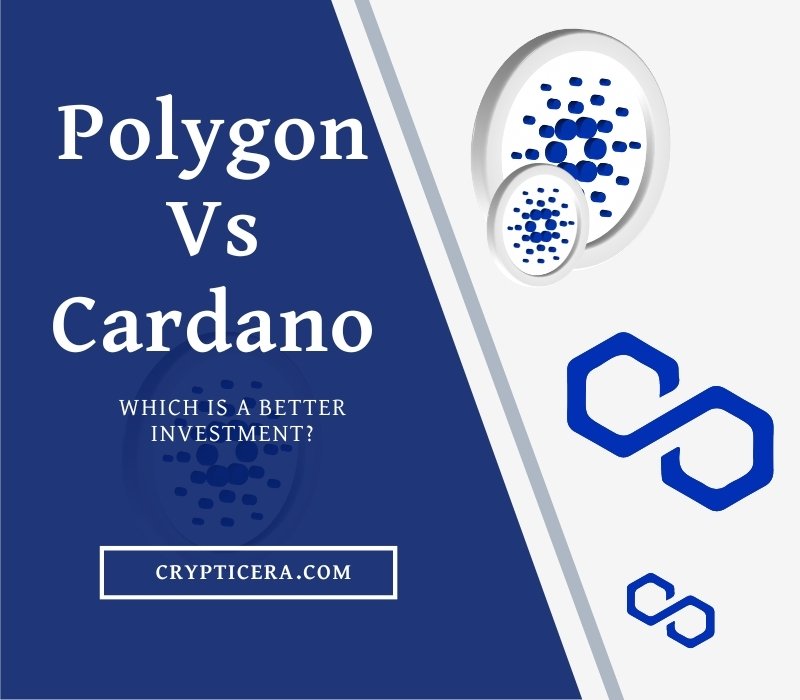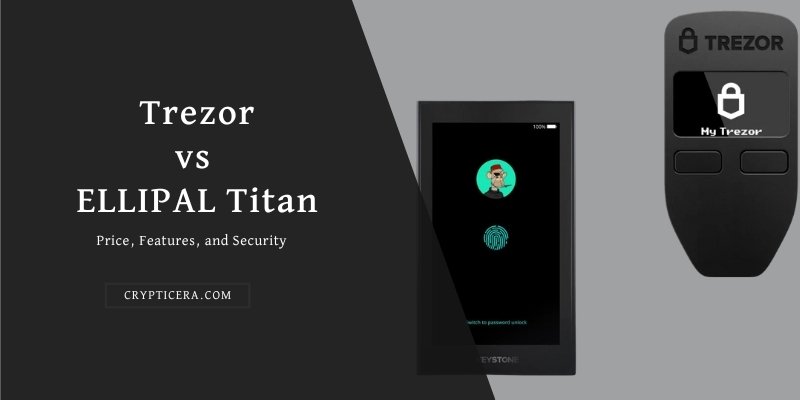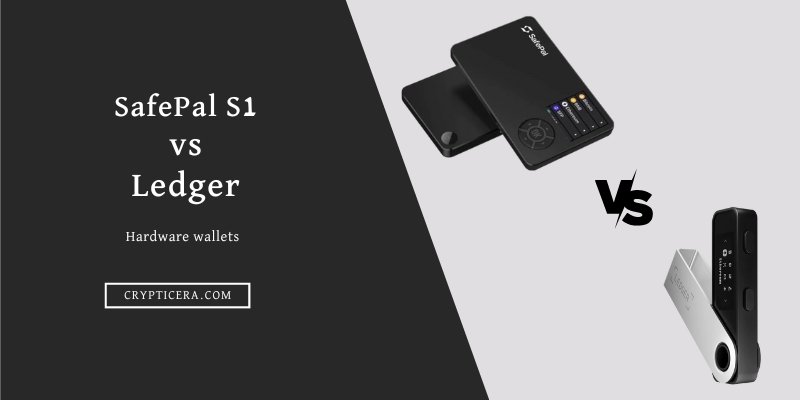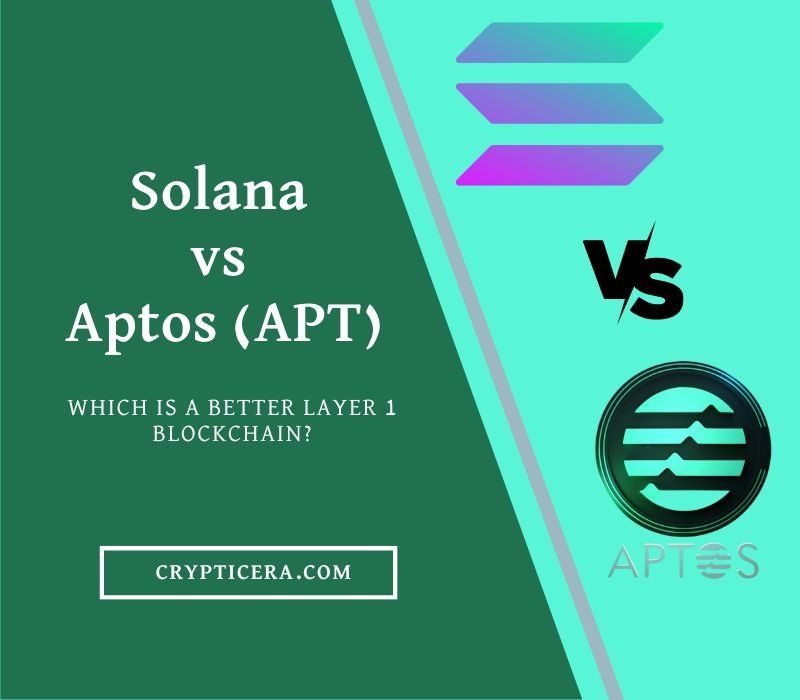Are you wondering which cryptocurrency to add to your portfolio? Look no further! In this post, we’re pitting two blockchains of the crypto world against each other: Polygon vs Cardano (ADA).
Both of these projects have made waves in the crypto space, but which one reigns supreme?
We’ll take a deep dive into the technology, adoption, and potential of each coin to help you make an informed decision.
So, grab your popcorn and get ready for a showdown of epic proportions as we determine which crypto giant will come out on top: Polygon or Cardano.
Key Differences:
- Polygon uses sidechains and Plasma technology to improve Ethereum’s scalability, while Cardano was built from scratch with scalability in mind using the Ouroboros consensus algorithm.
- Polygon is compatible with Ethereum Virtual Machine, allowing easy porting of dApps, while Cardano has its own programming language, Plutus, requiring developers to learn a new language.
- Cardano focuses on strong governance and decentralization, allowing stakeholders to have a say in decision-making, while Polygon is more centralized, with a smaller group of validators.
Comparison between Polygon and Cardano Network
| Feature | Polygon (MATIC) | Cardano |
|---|---|---|
| Launched date | 2021 | 2015 |
| Founders | Sandeep Nailwal, Jaynti Kanani, Anurag Arjun | Charles Hoskinson, Jeremy Wood, Aggelos Kiayias |
| Market cap | $8.7 billion | $13.1billion |
| Role | Layer 2 scaling solution on Ethereum | Blockchain platform |
| Scalability (TPS) | 1000-7000 TPS | 250 TPS |
| Security | High | High |
| Decentralized | Yes | Yes |
| Consensus mechanism | Proof of Stake | Ouroboros |
| Transaction fees | Low | Low |
| Smart contract language | Solidity | Plutus |
What is Polygon?
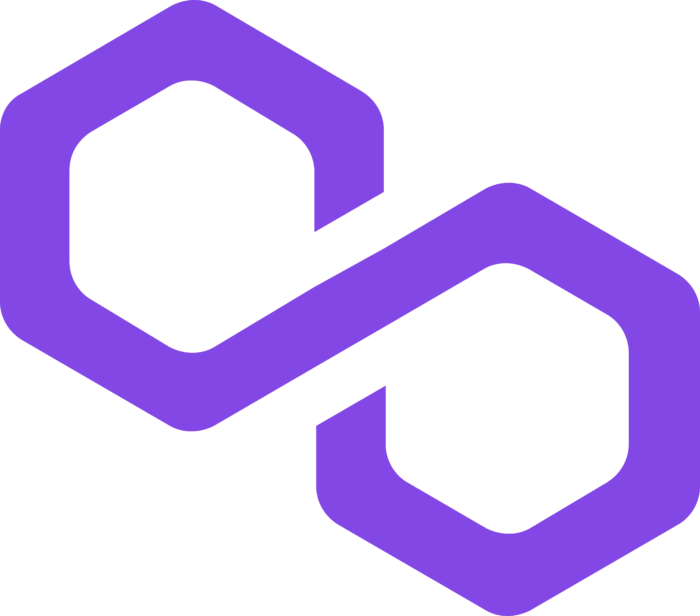
Polygon, formerly known as Matic Network, is a layer 2 scaling solution for Ethereum. It uses sidechains to speed up transactions and increase scalability on the Ethereum network.
One of the key benefits of Polygon is that it makes Ethereum more suitable for decentralized apps and other high-throughput use cases.
By increasing the speed and scalability of the network, Polygon allows these types of apps to run smoothly and efficiently on Ethereum.
This is important as decentralized apps have become more popular in recent years, they need a fast and reliable network to run on.
Also Read: Polygon vs Ethereum vs Solana
What is Cardano?
Cardano is a blockchain platform that aims to provide a secure infrastructure for smart contracts and decentralized apps. It uses a proof-of-stake consensus algorithm, making it more energy efficient than other blockchain networks.
The platform is being developed by IOHK, led by Ethereum co-founder Charles Hoskinson.
Cardano’s architecture separates the network’s settlement and computation layers, making it more flexible and efficient. It also emphasizes security and formal verification, increasing the overall security and reliability of the network and its apps.
The native cryptocurrency of the Cardano network is called ADA, which can be used to transfer value and participate in the network’s governance process.
How does Cardano Work?
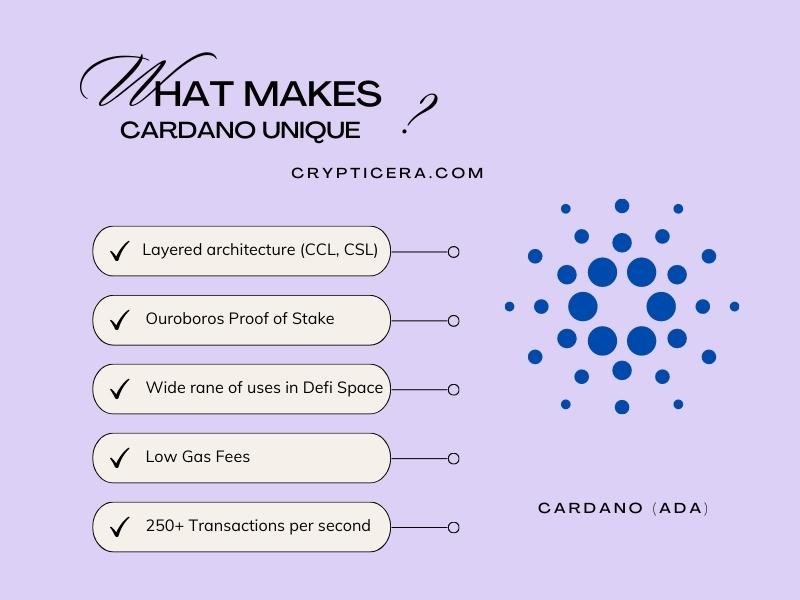
Cardano’s consensus algorithm, Ouroboros, is a proof-of-stake (PoS) algorithm that uses a stake-weighted voting system to validate transactions and create new blocks.
In this system, individuals who hold a stake in the network (i.e., ADA, the native cryptocurrency of Cardano) can participate in the validation process by “staking” their ADA and becoming a “slot leader”.
Slot leaders are chosen to create new blocks through a randomized selection process that takes into account the amount of stake they hold.
The network is divided into “epochs” and within each epoch, the slot leaders are chosen through a process called “slot leadership.” Slot leaders are responsible for creating new blocks and appending them to the blockchain.
They are also responsible for validating the transactions within the blocks they create.
Cardano’s multi-layer architecture separates the settlement and computation layers. The settlement layer is responsible for handling the transfer of value and the creation of new blocks.
The computation layer, on the other hand, enables smart contracts and other complex computations to be performed on the network.
This separation allows for more flexibility and scalability in the network.
Read Comparison: Cardano Vs Ethereum
Polygon Vs Cardano: Key Differences and Similarities
History and Development
Cardano is a blockchain platform that was created in 2015 by a team led by Charles Hoskinson, one of the co-founders of Ethereum.
Polygon is a blockchain platform that was launched in 2017. It is based on Ethereum and uses a modified version of the Ethereum proof-of-stake consensus algorithm.
In terms of Market Cap, Cardano has a market capitalization of around $13.1 billion, and it is currently ranked as the 7th largest cryptocurrency by market cap.
MATIC has a market capitalization of around $8.7 billion and it is currently ranked as the 11th largest cryptocurrency by market cap.
Network Scalability
Polygon (MATIC) and Cardano have different scalability capabilities. Polygon has higher scalability than Cardano.
It has a capacity of 1000-7000 TPS, while Cardano has a capacity of 250 TPS.
This means that Polygon is capable of handling more transactions per second, making it more suitable for high-traffic decentralized applications.
Security
Polygon uses a multi-chain architecture where each chain is secured by its own set of validators. This allows for faster transaction processing and lower fees, while still maintaining a high level of security.
Additionally, Polygon uses a Plasma-based system to ensure that all transactions are secure and can be audited if necessary.
Cardano, on the other hand, uses a unique consensus algorithm called Ouroboros. This is based on Proof-of-Stake (PoS) and is designed to be highly secure and energy-efficient.
Cardano also has a formal verification process, which allows developers to mathematically prove the correctness of their smart contracts. This further increases the security of the network.
Transaction Fees
Polygon (MATIC) uses a Layer 2 scaling solution, which allows for low transaction fees.
The cost of transactions on Polygon (MATIC) is determined by the amount of data included in a transaction and the amount of gas required to execute the transaction.
The average transaction fee on Polygon (MATIC) is between $0.0005 to $0.2.
Cardano also has low transaction fees. The average transaction fee on Cardano is around $0.17 ADA.
Smart Contract Language
Polygon uses Solidity as its primary smart contract language. Solidity is a contract-oriented, high-level programming language for implementing smart contracts on the Ethereum blockchain.
Solidity is a Turing-complete language which means it can handle any computational problem that can be solved with an algorithm.
Cardano uses a language called Plutus, which is based on Haskell. Haskell is a functional programming language, which is known for its strong type system and formal verification capabilities.
Plutus is specifically designed for use on the Cardano blockchain and allows for highly secure and efficient smart contract development.
Total Value Locked (TVL) in Defi
- According to Defillama, TVL in Polygon Defi is $1.19 billion with a 27.5% market dominance by AAVE Defi and the lending platform.
- TVL in Cardano Defi protocols is $77.16 million.
DApps Ecosystem
Polygon and Cardano are both blockchain platforms that allow for the development of decentralized applications (DApps).
The Polygon ecosystem has a large number of DApps built on it, including decentralized exchanges (DEXs), non-fungible token (NFT) marketplaces, and gaming platforms.
Here is the list of popular DApps on Polygon-
- Balancer
- 1inch Network
- Quicswap
- Odos
- CelerNewtork
The Cardano ecosystem is still relatively new, but it has a growing number of DApps being developed on it, including financial services and social media platforms.
- Minswap
- JPG Store
- Sundaeswap
- Wingriders
- Muesliswap
How to Buy MATIC and ADA?
You can buy MATIC and ADA on a variety of popular cryptocurrency exchanges, including Binance, Bitfinex, KuCoin, and Bybit.
- Bybit: A popular derivatives exchange offering leverage trading for BTC, ETH, ADA, and MATIC.
- KuCoin: A global cryptocurrency exchange with a wide variety of coins and strong community support.
- Binance: A popular global exchange with a wide variety of coins and a user-friendly interface.
- Bitfinex: A leading digital asset trading platform for professional traders and liquidity providers.
What is Layer-2 Scaling Solution?
A Layer-2 scaling solution is a way to increase the transaction throughput of a blockchain network.
This can be achieved by moving some of the transactions and their associated computations off of the blockchain’s primary “layer 1” and onto a secondary “layer 2” structure.
This can include solutions such as off-chain payment channels, state channels, and sidechains.
By doing so, the network is able to handle a greater number of transactions per second while still maintaining a high level of security and decentralization.
Example: Polygon (MATIC) is an Ethereum Layer-2 Scaling Solution
Read about Layer-2 Scaling Solutions: Arbitrum vs Polygon
Final Thoughts: Which is better
In conclusion, Polygon and Cardano are both blockchain platforms that have their own unique features and capabilities.
MATIC is a layer 2 scaling solution for Ethereum that allows for faster and cheaper transactions. Cardano, on the other hand, is a proof-of-stake blockchain platform that aims to provide a more secure and sustainable ecosystem for decentralized applications.
Both platforms have their own strengths and weaknesses and the choice between them will depend on the specific use case and requirements of the project.
It’s worth noting that both are still under active development and have great potential for growth in the future.
It’s important to conduct thorough research and analysis before making a decision on which platform to use for your project or Investment.
FAQs
Is MATIC a better Investment than Cardano?
Polygon (MATIC) and Cardano are both good investments as they both have vast use cases in the Decentralized Finance ecosystem. Polygon blockchain is used to increase the scalability of Ethereum DApps whereas Cardano is used to build its own Defi Apps.
Does Cardano have a future?
Cardano has already established itself as a notable blockchain project and has a strong community behind it. It is being actively developed and has a number of partnerships and projects in the works. As such, it is considered to be a promising project in the blockchain space with a potential future.
